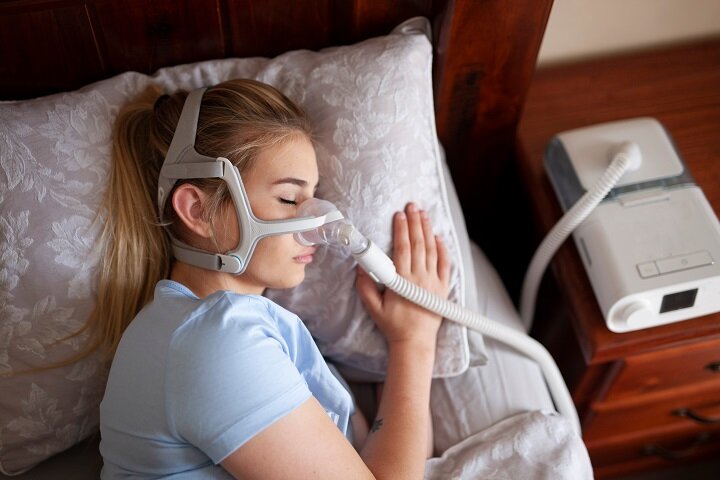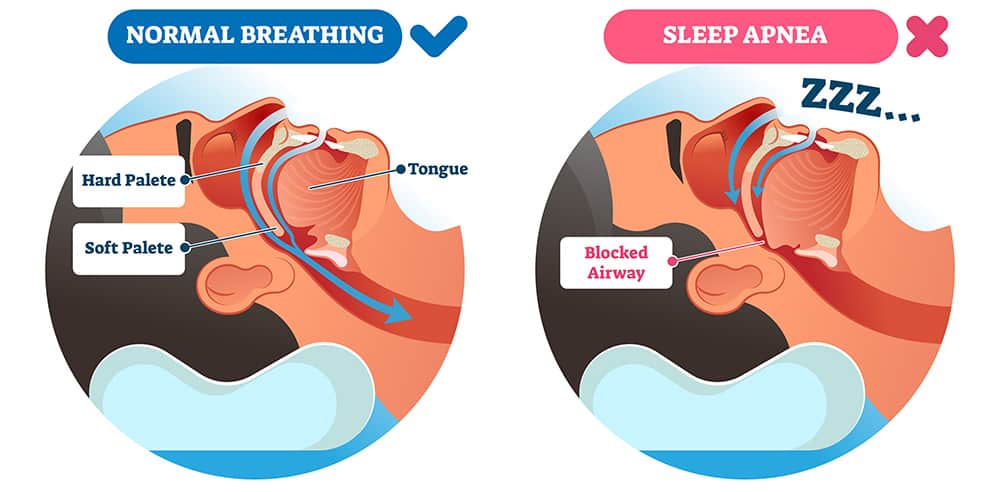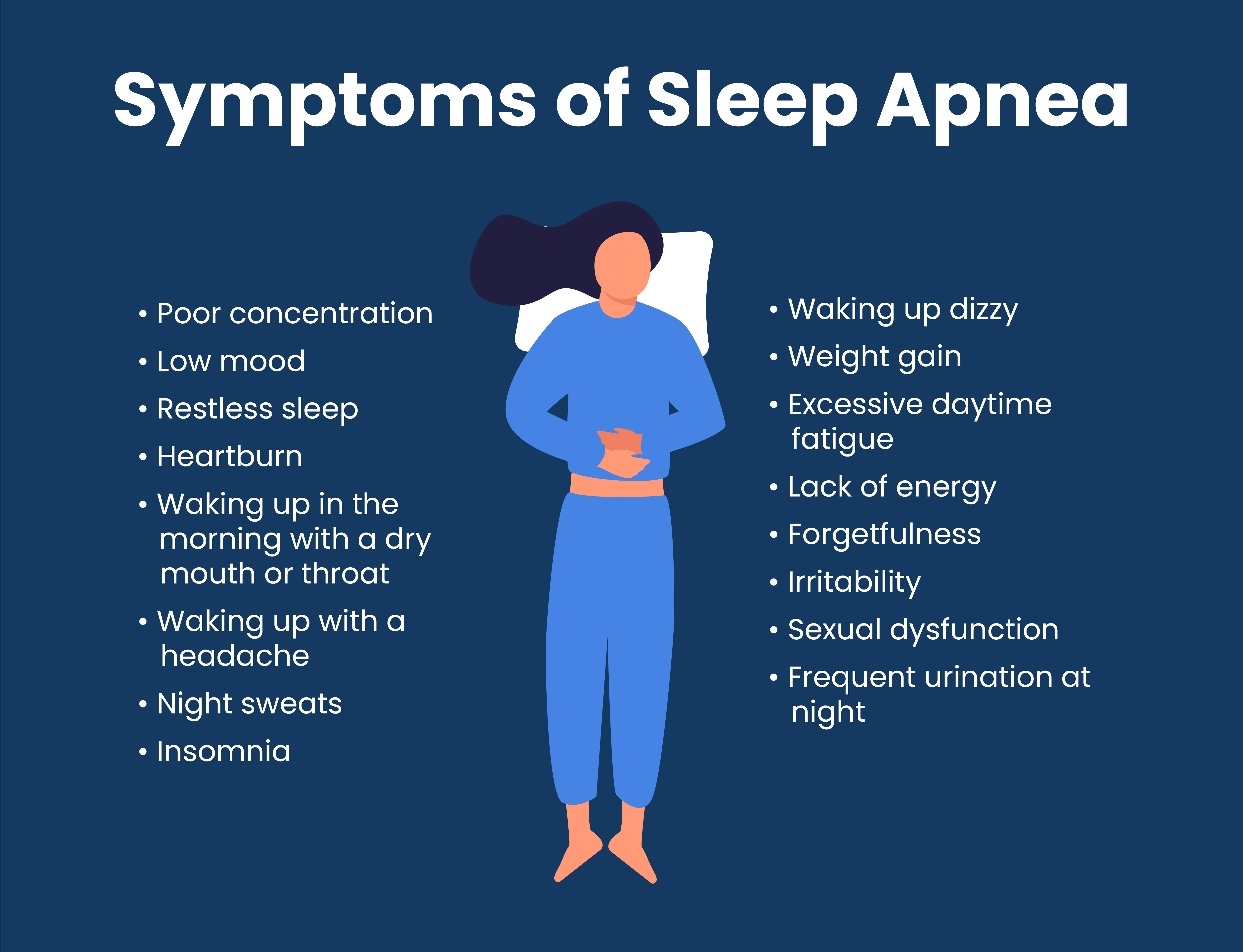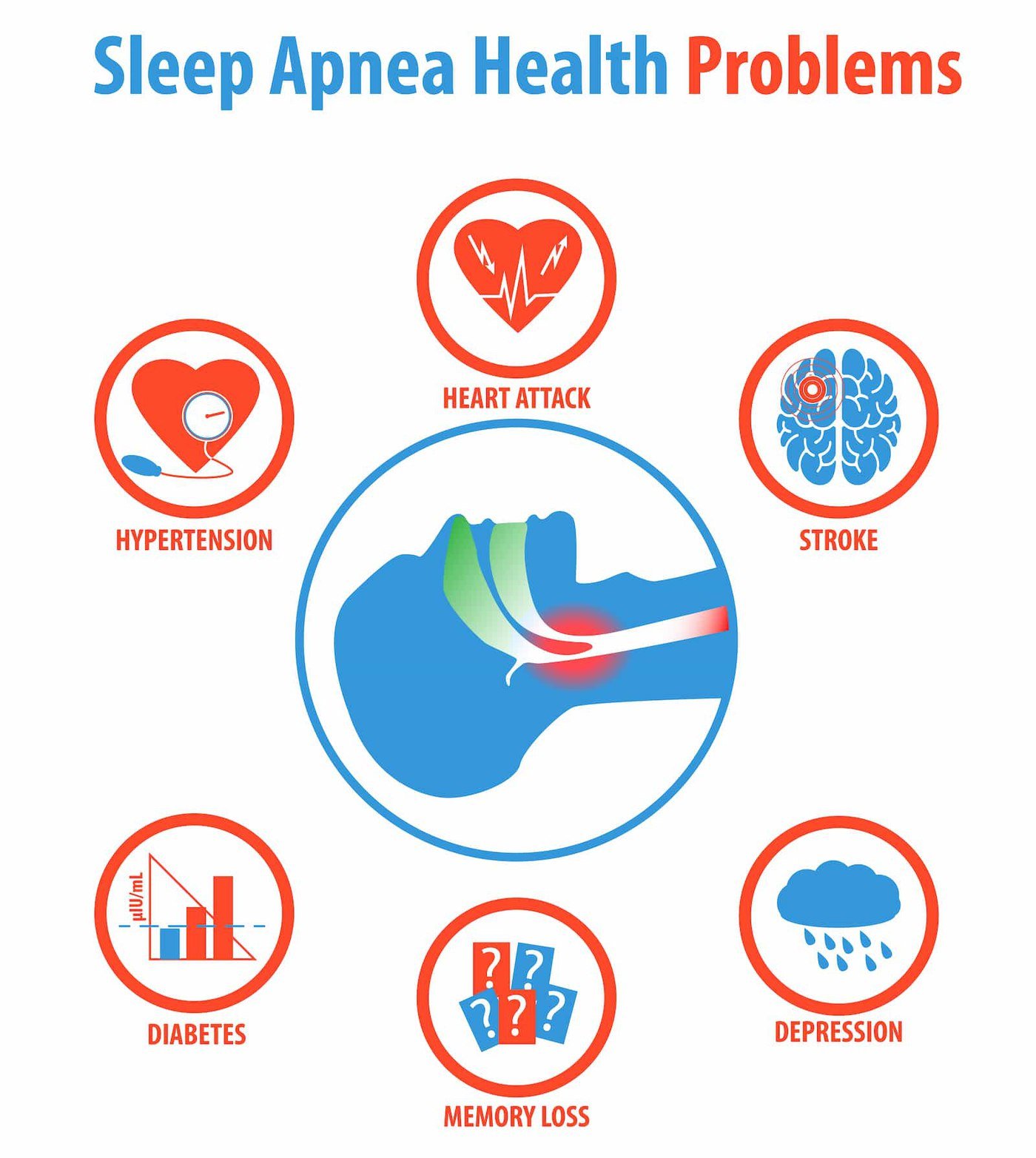
Sleep apnea is a disorder characterized by recurring breathing stops during sleep, disrupting normal oxygen and carbon dioxide exchange. Sleep apnea causes a drop in blood oxygen concentration and can have serious health consequences. Sleep apnea is divided into two main forms: obstructive sleep apnea (OSA) and central sleep apnea (CSA), which differ in their causes, mechanisms of manifestation, and treatment methods.
Obstructive Sleep Apnea (OSA) is the most common form, caused by upper airway obstruction during sleep. This happens when the soft tissues in the throat, including the tongue and soft palate, relax and block the airways, disrupting normal airflow. Obstructive Sleep Apnea is associated with numerous risk factors, including obesity, anatomical throat structure features, age, gender (more common in men), alcohol consumption, and smoking. OSA symptoms include loud snoring, breathing pauses, frequent nighttime awakenings, daytime fatigue, morning headaches, and concentration difficulties.
Central Sleep Apnea (CSA) is a less common form, where breathing stops occur due to insufficient brain signaling to the muscles responsible for breathing. Unlike OSA, there is no physical obstruction to airflow in CSA, but rather a problem with the brain's ability to maintain respiratory function. Central Sleep Apnea can be associated with other medical conditions, such as heart failure, brain damage, or the use of certain medications. CSA symptoms are similar to OSA, including nighttime sweating, fatigue, and daytime sleepiness, but snoring may be less noticeable.

What causes sleep apnea?
Sleep apnea can arise from various causes, depending on the type of apnea – obstructive sleep apnea (OSA) or central sleep apnea (CSA). These breathing disruptions during sleep not only disrupt healthy sleep but can also have long-term negative consequences for health.
Causes of Obstructive sleep apnea
Obstructive Sleep Apnea occurs when the upper airway's soft tissues, such as the tongue, soft palate, and throat walls, relax during sleep and block the airways, disrupting normal airflow. Various factors contribute to this:
- Obesity and overweight: A high body mass index (BMI) is a primary risk factor for OSA because additional fat in the throat can compress and block the airways.
- Anatomy: A narrower throat, larger tongue, or specific jaw structure can increase the risk of OSA.
- Age: The risk of developing Obstructive Sleep Apnea increases with age as muscle tone decreases, and soft tissues can more easily block the airways.
- Gender: Men are more likely to suffer from Obstructive Sleep Apnea than women, possibly due to different body compositions and hormonal effects.
- Alcohol consumption and medications: Alcohol and certain medications can relax the throat muscles, thereby increasing the risk of OSA.
- Smoking: Smoking is associated with inflammation and swelling in the throat, which can also contribute to airway obstruction.
Causes of Central Sleep Apnea
Central Sleep Apnea is related to insufficient brain signals that regulate breathing, causing breathing to become inadequate or stop during sleep. The main causes of CSA include:
- Heart failure and other heart diseases: These conditions can disrupt the normal mechanism of breathing control.
- Brain injuries: Brain stroke, brain tumors, or other conditions affecting brain parts responsible for breathing regulation can cause CSA.
- Altitude: Living or sleeping at high altitudes can cause central sleep apnea due to changes in blood oxygen concentration.
- Drug and medication use: Some medications, especially opioids, can disrupt breathing control, causing CSA.
Both Obstructive Sleep Apnea and Central Sleep Apnea can have serious health consequences, so it's important to recognize symptoms and seek healthcare professionals for proper diagnosis and treatment. Treatment strategies can include lifestyle changes, various measures to open the airways, such as CPAP devices for OSA, or specific treatment to eliminate the causes of CSA.

What symptoms does sleep apnea cause?
Sleep apnea, a disorder characterized by recurrent breathing stops during sleep, can cause various symptoms that not only disrupt individuals' sleep quality but can also have long-term negative health consequences. The symptoms of sleep apnea can vary depending on the disorder type – obstructive sleep apnea (OSA) or central sleep apnea (CSA) – but many symptoms are common to both forms.
Main symptoms of Sleep Apnea
- Loud snoring: The most commonly occurring symptom, especially in OSA. Snoring can be interrupted by breathing pauses, known as apneas.
- Breathing pauses: The person may experience one or several seconds of breathing pauses, which can be noticed by others.
- Sudden awakening with a feeling of suffocation: Due to the breathing stop, the person may suddenly wake up feeling suffocated or short of breath.
- Dry mouth or throat in the morning: Due to breathing through the mouth during sleep, a feeling of dryness may occur.
- Morning headaches: Due to the lack of oxygen and accumulation of carbon dioxide in the blood at night, headaches may arise.
- Daytime fatigue and sleepiness: Despite a full night's sleep, the person may feel constantly tired and drowsy during the day.
- Attention difficulties: Difficulty concentrating or remembering information due to insufficient rest.
- Irritability and mood swings: Due to inadequate sleep, emotional instability, irritability, or depression may occur.
- Night sweats: Increased sweating during sleep may be related to efforts to restore breathing.
- Increased nighttime urination: Changes in hormones regulating urine production can cause more frequent nighttime urination.
While these symptoms may indicate the presence of sleep apnea, accurate diagnosis typically requires a sleep study, such as polysomnography. It's important to pay attention to these symptoms and consult a healthcare professional, as untreated sleep apnea can increase the risk of heart diseases, high blood pressure, stroke, type 2 diabetes, depression, and other health problems. Additionally, daytime fatigue and sleepiness can negatively affect work performance, personal relationships, and increase the risk of traffic accidents.
What complications can sleep apnea cause?
Sleep apnea can cause not only discomfort and reduce the quality of life but also lead to serious health complications. These complications arise due to a lack of oxygen in the blood and sleep disturbances, which have various effects on the body's systems. Sleep apnea complications include cardiovascular diseases, metabolic disorders, neurocognitive defects, and psychosocial problems.
Cardiovascular complications
One of the most well-known complications of sleep apnea is an increased risk of heart disease. Breathing stops during sleep cause fluctuations in blood pressure and increase the heart's workload, leading to hypertension. Prolonged oxygen deprivation also increases the risk of coronary artery disease, heart failure, and arrhythmias, especially atrial fibrillation.
Stroke risk
Sleep apnea is a known independent risk factor for stroke. Breathing disturbances and oxygen deprivation can cause vascular damage and increase blood clotting, thereby increasing the risk of stroke.
Metabolic disorders
Sleep apnea can also affect metabolism, increasing the risk of type 2 diabetes and obesity. Breathing pauses and oxygen deprivation cause hormonal changes that can disrupt glucose tolerance and insulin sensitivity, as well as stimulate appetite and reduce the feeling of satiety.
Neurocognitive defects
Due to insufficient sleep quality and oxygen deprivation, sleep apnea can negatively affect cognitive functions, including memory, attention, and decision-making. This can lead to decreased work performance, an increased risk of accidents, and an overall decline in quality of life.
Psychosocial consequences
Sleep apnea can cause or worsen mental health issues, including depression and anxiety. Constant fatigue, daytime sleepiness, and overall health deterioration can affect personal relationships, social activities, and overall well-being.
Quality of life reduction
All these complications together can significantly reduce the quality of life for individuals with sleep apnea. Health problems, combined with constant fatigue and reduced work capacity, can complicate daily activities and reduce life enjoyment.
To avoid these serious complications, it is very important to diagnose and effectively treat sleep apnea early. Lifestyle changes, breathing aids such as CPAP devices, and sometimes surgical interventions can help control sleep apnea symptoms and reduce the risk of associated complications.

Sleep apnea prevention
Preventing sleep apnea is an important aspect of avoiding the health problems it causes and ensuring a better quality of life. Although some risk factors for sleep apnea, such as genetics or anatomy, cannot be controlled, there are several lifestyle changes and measures that can help reduce the likelihood of developing this disorder or alleviate its symptoms.
Weight control
Overweight and obesity are among the main risk factors for obstructive sleep apnea (OSA) because additional fat in the neck area can compress the airways, obstructing airflow. Weight loss can significantly reduce the risk of airway obstruction and improve breathing during sleep. Regular physical activity and a balanced diet are key aspects of weight control.
Limiting alcohol and sleep-affecting medications
Alcohol and some sleep-affecting medications can relax the throat muscles, thereby increasing the risk of airway obstruction. Avoiding or limiting the use of these substances, especially before bedtime, can help prevent breathing disturbances during sleep.
Quitting smoking
Smoking is associated with inflammation and swelling in the airways, which can make breathing during sleep more difficult. Quitting smoking can reduce the level of inflammation and improve air flow quality.
Changing sleep position
Sleeping on the back can increase the likelihood of the tongue and soft tissues falling into the airways, so sleeping on the side can be a useful measure to reduce the risk of breathing disturbances.
Regular physical activity
Physical activity not only helps control weight but also improves overall health, including the respiratory system's function. Regular exercise can help prevent sleep apnea or alleviate its symptoms.
Healthy diet
A balanced diet rich in fruits, vegetables, proteins, and low in saturated fats can help maintain a healthy weight and reduce the risk of sleep apnea.
Stress management
Stress can affect sleep quality and duration, as well as encourage unhealthy habits, such as excessive alcohol consumption. Stress management practices, such as meditation, yoga, or deep breathing, can help improve sleep quality.
While it's not always possible to completely avoid sleep apnea, these prevention methods can help reduce the risk or alleviate the disorder's symptoms. If you notice symptoms of sleep apnea, it's important to consult a healthcare professional who can conduct a thorough evaluation and recommend the most appropriate treatment plan.
Information sources:
- Harrison's Principles of Internal Medicine
- Sleep Medicine Reviews journal
- American Journal of Respiratory and Critical Care Medicine
- Journal of Clinical Sleep Medicine
# miego apnėja






